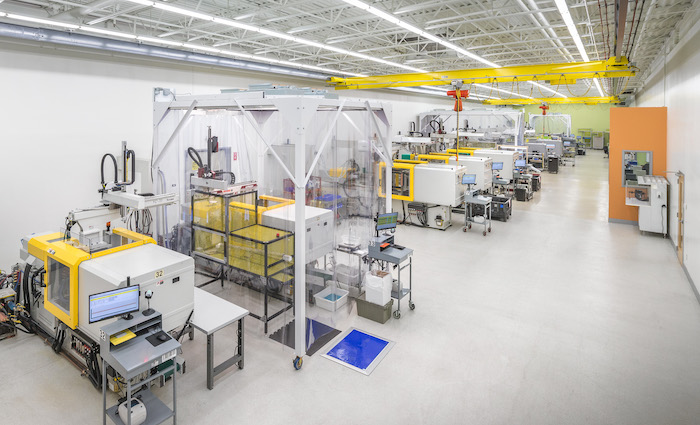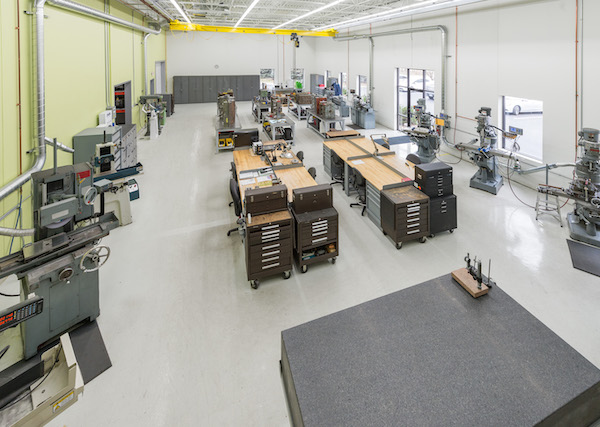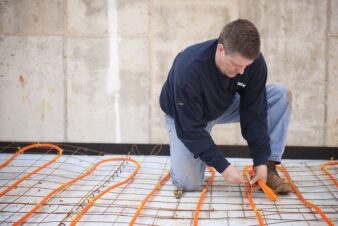BY JOHN O’REILLY
Circle Pines, a Minnesota-based injection-molding company, more than doubles its vendor report card score in only two years by aggressively boosting its performance in energy conservation, packaging materials, health and safety audits, and other areas.
Few things in this world can be factually characterized as truly “unique”—as in “one of a kind,” “nothing like it anywhere else.” But for Eric Eichten, “unique” is an absolutely spot-on summation of the three-year-old Uponor Sustainability Report Card questionnaire process.
“We have had customers who’ve required this sort of vendor survey maybe one time—like when we are just starting a relationship,” says Eichten, who serves as customer relations lead at Advanced Molding Technologies (AMT) in Circle Pines, Minn. “But for the most part, sustainability has been almost an afterthought. The focus Uponor has devoted to sustainability—and the value their management ascribes to it year-in and year-out—is not something I have seen elsewhere.”A plastic-injection molder, AMT has been supplying Uponor engineered plastic pipe fittings for use in the latter’s crosslinked polyethylene (PEX) piping systems for more than two decades. In fact, AMT founder and owner Brett Nelson previously worked with Uponor (then known as “Wirsbo”) at another vendor before launching AMT in 1999.

Press room: AMT injection molding presses on the company’s molding floor.
Uponor Engineered Polymers category manager Loren Boerboom, whose Supply Chain team works with Eichten, describes AMT as a “very sophisticated company and a strong supplier. Technology-wise, they are top notch, and they adhere to our demanding standards for fittings.”
Nonetheless, three years ago, when AMT management received the inaugural version of the now-annual sustainability questionnaire, it came as a bit of a jolt, recalls Eichten. “I don’t know that ‘surprised’ is the right word, but I can’t say we were expecting all the questions it asked. The survey was an eye-opening experience, to say the least.”

Tool room: Where AMT’s injection molds are cleaned and maintained for customers.
That first year, 2017, AMT earned 12 points out of a possible 53 on the 23-question form, earning a “C rank.” The next year, the company more than doubled its total to 25 (again out of 53), raising its rank to “B.” (Survey questions are kept the same from year to the next, “so that we are comparing ‘apples to apples,’” says Boerboom.) In 2019, AMT increased its point total again, to 27, further bolstering its “B” rank.
Rather than regarding that first questionnaire as an imposition—let alone an abuse of the leverage a buyer might hold over a long-time supplier—AMT quickly embraced the process as “motivational,” according to Eichten. “The Uponor survey has shown us where exactly we need work, where we could improve.”
Proactive approach
What most impressed Boerboom and the other members of his team was the proactive manner in which AMT used its survey results to pursue internal improvements. “They actively reached out to our company, holding meetings with our sustainability people to get ideas: ‘What can we do to align with Uponor when it comes to sustainability?’”
Over the past three years, AMT has achieved improvements in numerous areas, but three are particularly notable:
- Corporate social responsibility (CSR): In 2017, AMT had no formal, written CSR or sustainability policy. Led by its CEO and the company’s human resources department, AMT built one from scratch in 2017-2018, generating five additional points on the second survey.
“We want to be a great injection-molding company,” says Eichten, who has worked at AMT the past seven years, five of them on the Uponor account. “When we had to answer that question ‘no’ in 2017, we also recognized it as a huge opportunity to improve. Brett and our HR people worked the better part of a year on the new statement,” which now lives in the company’s employee handbook.”
- Reductions in energy consumption: In AMT’s injection-molding process, large amounts of energy are expended heating the tool. An ongoing problem was the amount of heat lost during the process: Cut that heat-loss total, and a significant amount of energy could be saved.
“To reduce heat loss, we added insulator plates where we have a steel tool sitting on top of the steel platen of an injection-molding machine,” explains Eichten. “So, instead of heating the machine, most of the heat is now concentrated by the insulator on the molding tool.”
Although it is difficult to quantify the precise energy savings, Eichten estimates that this simple move to insulation has had a substantial, positive impact. “We believe that it saves us roughly 30 minutes at the startup of a tool,” he explains. “Then, over the course of a production run, we need less energy to maintain a set temperature in that tool.”
- Reductions in packaging materials and shipping distances: AMT maintains approximately 80,000 square feet under roof in two buildings located cater-corner to one another in Circle Pines. Injection molding is done in one facility; packaging, the other. Bulk product movement between the two is done with large, palleted and—here’s the key—reusable plastic cartons, called “gaylords,” the name of their manufacturer.
“The plastic pallets are filled at our production facility,” says Eichten, “and the contents are transported to the second building for packaging, while the gaylords return to the first building for repeat refilling. We use the same cartons over and over.”
“Long way to go”
AMT management recognizes that much of the “low-hanging fruit” in process improvement has already been plucked, and that future improvement projects will be larger, perhaps more complicated, and most likely more costly. As an example, Eichten points to replacing more than 80,000 square feet of fluorescent lighting in the two facilities.
“We want to substitute LED lights, and that is a much larger, more costly and difficult process to tackle,” he continues. “But the LED switch may also have greater impact in the long run in terms of energy savings.”
In its aggressive move to embrace sustainability, AMT “still has a long way to go,” Eichten concedes. “We are aware of a lot of large projects out there that we definitely want to complete. But we are also looking forward to taking those next steps.”



